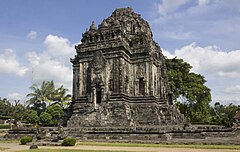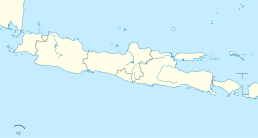Candi Kalasan
| Kalasan Temple | |
|---|---|

Kalasan Temple
|
|
|
Location within Java
|
|
| General information | |
| Architectural style | Buddhist candi |
| Town or city | Kalasan, Sleman Regency, Special Region of Yogyakarta |
| Country | Indonesia |
| Coordinates | 7°46′12″S 110°28′12″E / 7.770°S 110.470°E |
| Completed | circa 8th century |
| Client | Sailendra |
Kalasan (Indonesian: Candi Kalasan), also known as Candi Kalibening, is an 8th-century Buddhist temple in Java, Indonesia. It is located 13 km east of Yogyakarta on the way to Prambanan temple, on the south side of the main road 'Jalan Solo' between Yogyakarta and Surakarta. Administratively, it is located in the Kalasan District of Sleman Regency.
According to the Kalasan inscription dated 778 AD, written in Sanskrit using Pranagari script, the temple was erected by the will of Guru Sang Raja Sailendravamçatilaka (the Jewel of Sailendra family) who succeeded in persuading Maharaja Tejapurnapana Panangkaran (in another part of the inscription also called Kariyana Panangkaran) to construct Tarabhavanam, a holy building for the goddess (boddhisattvadevi) Tara.
In addition, a vihara (monastery) was built for buddhist monks from the Sailendra family's realm. Panangkaran awarded the Kalaça village to sangha (buddhist monastic community). According to the date of this inscription, Kalasan temple is the oldest of the temples built in the Prambanan Plain.
Despite being renovated and partially rebuilt during the Dutch colonial era, the temple currently is in poor condition. Compared to other temples nearby such as Prambanan, Sewu, and Sambisari the temple is not well maintained.
The temple stands on square 14.20 meters sub-basement. The temple plan is cross-shaped, and designed as a twelve-cornered polygon. Each of four cardinal points has stairs and gates adorned with Kala-Makara and rooms measuring 3,5 square meters. No statue is to be found in the smaller rooms facing north, west, and south; but the lotus pedestals suggest that the rooms once contains statues of Bodhisattvas. The temple is richly decorated with buddhist figures such as the Bodhisattva and gana. The Kala Face above the southern door has been photographed and used by a number of foreign academics in their books to give an idea of the artistry in stone by Central Javanese artists of a millennia ago. Niches where the statues would have been placed are found inside and outside the temple. The niches adorned an outer wall intricately carved with Kala, gods and divinities in scenes depicting the svargaloka, celestial palace of the gods, apsaras, and gandharvas.
...
Wikipedia

